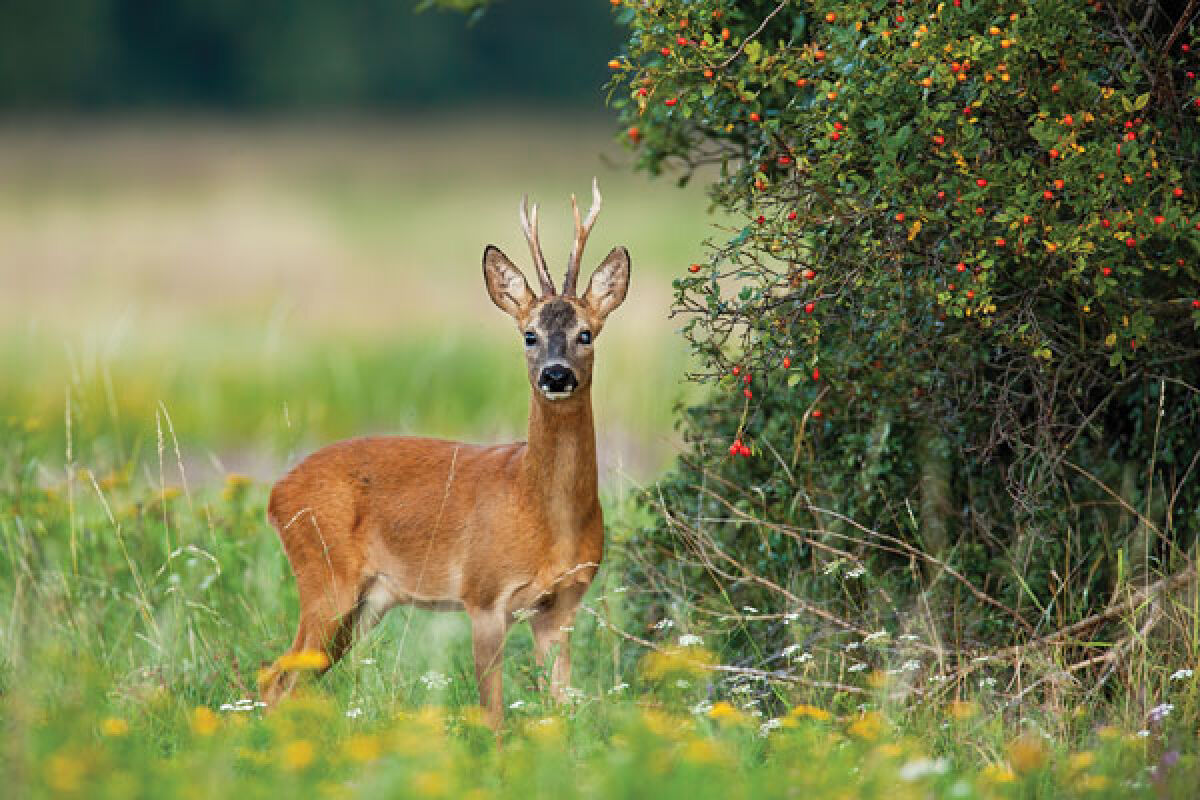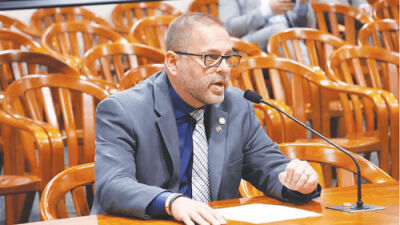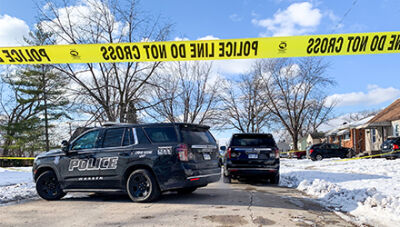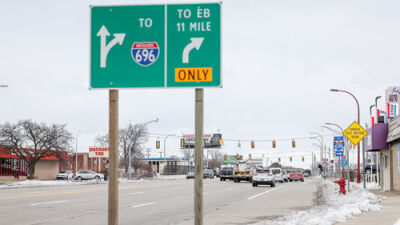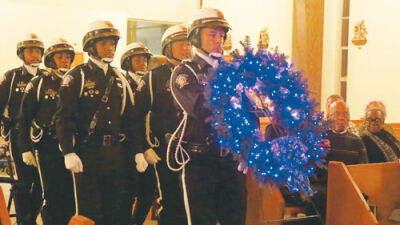METRO DETROIT — Multiple local communities have taken a step toward trying to figure out what to do about the large number of deer roaming the region.
To address concerns, the Oakland County Community Deer Coalition was created in 2021 by a group of leaders in nine Oakland County communities, according to a press release.
The release states that in recent years the deer population has grown steadily throughout Oakland County, which has led to an increase in the number of deer-related auto accidents, damage to landscaping and private property, and greater potential for Lyme disease and other illnesses that can be spread by deer.
Farmington, Farmington Hills, West Bloomfield, Auburn Hills, Beverly Hills, Birmingham, Franklin, Rochester Hills and Southfield are all part of the coalition.
According to the release, over the past few years, cities and townships throughout Oakland County have received a rising number of calls and emails from concerned residents.
The coalition recently partnered with the Southeast Michigan Council of Governments, also known as SEMCOG, in an effort to come up with a regional solution to address the deer population.
The coalition has also been working with the Michigan Department of Natural Resources to try to formulate a regional plan.
In Southfield, deer were the subject of a town hall meeting that took place Sept. 22. In particular, the town hall presented a forum to discuss the city’s decision to include language on the Nov. 8 ballot, in relation to deer.
“We had a town hall to explain our ballot initiative — our nonbinding referendum on the November 8th ballot,” said Southfield Mayor Kenson Siver. “We’re asking to kind of measure the feeling of the community, regarding possibly culling the deer herd. We’re not talking about totally removing deer. We’re talking about reducing their numbers.”
Siver said that “the deer are everywhere in the city.”
He discussed the result of a study that was conducted.
“The study points out that the deer are doing more damage than we thought, and it’s not just about people’s landscaping,” Siver said. “They are creating an ecological imbalance, and by that I mean they’re eating a lot of wildflowers, which bees (and) butterflies depend on. They’re eating a lot of acorns, which squirrels depend on. Squirrels also bury acorns, which become new oak trees.”
Siver added that, “Too many deer are not good for the deer herd because they overgraze, but (it) also impacts other species, both plant and animal life.”
Despite some of the issues caused by deer, Siver understands that some residents prefer that they continue to have a place in the community.
“We know that there are strong opinions about the deer; a lot of people enjoy seeing them,” he said. “The city is not proposing to eradicate deer from the city; that would never happen. But we have areas, square miles, where we have as many as 80 deer. That is four times over what scientists tell us is sustainable for the herd.”
The feedback that Southfield gets from its Nov. 8 ballot will not necessarily determine the ultimate fate of deer in the city.
“Even if the majority of people vote to cull the herd, it doesn’t mean it’s going to happen,” Siver said. “Culling the herd is expensive, and we’d have to figure out what means would be used if the City Council decides to go ahead with culling the herd. … This is strictly an advisory question. We just need to get a sense of where the public is.”
Farmington Hills Assistant City Manager Joe Valentine stated that Farmington and Farmington Hills were the first communities to endorse a coalition.
In recent years, Farmington Hills has utilized helicopters to try to determine the number of deer in its city.
According to statistics provided by Valentine, earlier this year, 521 deer were counted in the Farmington and Farmington Hills area.
Last year, 729 were reported, which was an increase from the 370 that were counted in 2019.
An aerial count was not conducted in 2020.
As a first step in the process of attempting to identify a solution, the coalition is conducting a survey of Oakland County residents and business owners to gather data.
Valentine and Farmington Hills Deputy Director of Special Services Bryan Farmer represent Farmington Hills as part of the coalition.
“The first step in that process is the public engagement piece to gather the data as to what the concerns are … and then trying to work on solutions from there,” Valentine said. “That’s why we’re issuing the survey (and) working with SEMCOG – recognizing this is a regional issue; this isn’t just a local issue. There’s no real solution for us at this time, so by having the coalition work together and working with the state, pulling in the DNR, (we’re) trying to identify the best solution going forward, once we have a clear handle on all the concerns that we’re hearing in the region.”
The survey can be completed through Nov. 11 by visiting cobaltcommunityresearch.org/deer.html.
West Bloomfield is the only township among the communities that is part of the coalition, and it is represented by Supervisor Steven Kaplan.
“We have 68,000 residents in West Bloomfield (and) maybe 25 have contacted the township. A majority of those are in favor of removing the deer one way or the other,” Kaplan said. “The complaints voiced by our residents involve one or two matters – one or both. … One would be (that) the deer are trampling on vegetable gardens and flowers in back and front yards, and the second one is the possibility of a serious motor vehicle collision between a vehicle and a deer.”
SEMCOG’s website tracks deer crashes across the region. According to its statistics, between 2017 and 2021, 434 vehicle crashes involving deer were reported in West Bloomfield, with none being fatal, and one listed as serious.
During that same time period, there were 555 deer-vehicle crashes reported in Farmington Hills, with no fatalities and two reported as serious.
There were 25 deer-vehicle crashes in Farmington, with no injuries reported.
“Oakland County has the highest number of car-deer crashes in the state of Michigan,” Valentine said. “If you think about it, it’s kind of a unique situation. When you think about Oakland County, you wouldn’t think about deer; you’d think northern Michigan or the UP would have a large deer population to be supported.”
Despite that, Valentine said, “We have a lot of habitat for deer in our area.”
“In the northern part of the state there’s a lot more property for the deer to not have these interactions with traffic as much because there’s less roads, less density, and you might still have a large deer population, but because of less roads and less density you’re not having the concern that you’re seeing in the urban communities or even suburban communities,” Valentine said. “We’re trying to develop a plan that will address the unique environment that we have in these urban and suburban communities that are dealing with (the) large deer population. … These river corridors and greenway corridors allow them to traverse safely … and they have all the vegetation from homes they can use to support themselves and stay healthy.”
Kevin Vettraino is the planning director for SEMCOG. He thinks that statistics don’t completely represent the number of actual deer-vehicle crashes that occur in the region.
“We track it primarily (through) crashes, and we know that they’re underrepresented, generally, because if you strike a deer. … if very little damage is done, oftentimes those aren’t reported,” he said.
Chad Stewart is a deer management biologist with the Michigan Department of Natural Resources. He discussed the DNR’s role with the coalition.
“We’re primarily there in an advisory capacity, just sort of helping guide, in terms of process, or provide an understanding of state requirements, and then any other input that is needed as they work through this topic,” Stewart said.
Stewart referred to the coalition that has been created as a “groundbreaking effort.”
“The county coalition that we’ve been working with and (that) has been put together so far, I’m not aware of any other groups of communities that are doing anything similar to this, so I think it’s innovative; I think it’s a great way to approach it,” he said. “I’m excited to … continue working with them to see how their progress moves forward.”
Kaplan shared his opinion as to a couple of the reasons deer are attracted to the area.
“One is, there are good-intentioned people, homeowners, who leave food for the deer; and a deer has a good memory. A deer will remember who fed him, and that can cause deer to congregate in a particular neighborhood,” he said. “But then, when roads are built, when more roads are constructed, that takes away space where the deer can galavant … and that causes them to travel to residences – subdivisions.”
Vettraino shared the kind of information that can be ascertained from the survey.
“Within the questions being asked, you’ll be able to provide a ZIP code, where we can get a better sense of where within the region we’re seeing more encounters; so that’s part of the survey,” he said. “Other part is, generally, getting a feeling from those who are taking the survey – do they like to see the deer? (In) some cases, they do. … It’s part of that mix between rural living with urban living. … Is that their feeling towards it, or have they had different instances where they feel it more on the nuisance end, (whether) that’s a crash, aggressive behavior, or interactions with pets – landscaping?”
Vettraino discussed the significance of residents taking time to complete the survey.
“Before we put in any recommendations through a plan or policies, we wanna get that voice from the residents,” he said. “That’s another reason why it’s important for folks to take the survey, to better represent how to move forward.”
Potential solutions that have been discussed by community members have included finding a way to relocate deer to a more suitable part of the state, lacing food with contraceptives so that female deer cannot become impregnated, doing nothing, or culling them.
“There’s no solutions being considered until we have the data to support what issues we (want to) address,” Valentine said. “Once the coalition has the data, after Nov. 11, then they’ll start to work with the DNR to kinda drill down on focus areas of the concerns, and then start to evaluate alternatives for how to deal with those concerns.”
Stewart shared a similar sentiment.
“I think it’s too early to say anything,” he said. “The next step is probably developing a plan. … I think it’s important to understand what each community is dealing with, maybe some of the challenges – whether it’s landscape damage, whether it’s deer-vehicle collisions; and then from that point you can customize your management approach to try to address the problems in each community, specifically.”
Kaplan has given some thought to what he hopes the coalition can accomplish.
“Ideally, the coalition would fashion a remedy where the deer population would be reduced substantially, but not totally. … Without being inhumane,” he said. “In other words, nobody’s suggesting that a city hire a group of paratroopers (to) extinguish the deer. Nobody would suggest that.”
From Stewart’s perspective, a regional approach may be the only way of effectively solving the deer population issue.
“The problem that I think a lot of communities in Oakland County are experiencing is that so many of those communities are adjacent to one another,” he said. “They really need to be on the same page, in terms of their management approach or management decisions, because one community going sort of off on their own to try to resolve a problem might not have that much of an impact because the three surrounding communities have decided not to pursue any type of deer management, and now, because deer don’t recognize city boundaries, they’re gonna continue to move between communities, between cities. They might not have the full experience or benefit of the management program if other communities aren’t also involved.”
Valentine isn’t expecting an overnight solution to an issue that has been years in the making.
“We understand that this process isn’t the quickest to developing solutions,” he said. “Our intent is to make a lasting impact with the solutions that we would develop. … It’s trying to take the science part of what is needed to make a lasting impact on this issue, rather than just provide a solution for one year. … The coalition is now starting to develop into a regional entity that I think can make some real differences going forward, which we did not have previously.”
 Publication select ▼
Publication select ▼